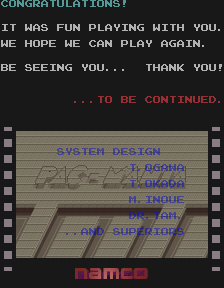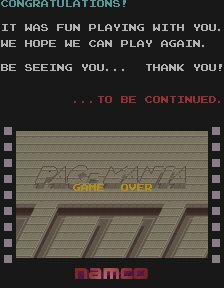Pac-Mania (Arcade)
| Pac-Mania |
|---|
|
Developer: Namco
|
Pac-Mania is yet another Pac-Man arcade game. It differs from the others by the ability to jump and the possibility of up to 11 ghosts in a level (some of whom can also jump).
Contents
Unused Graphics
Title Screen

Some larger sizes of the Pac-Man head seen on the title screen in the international version. While the third one has its own "highlight" graphic (as the full sprite is made by layering two separate ones together), it's just a duplicate of one of the smaller ones and does not properly fit.

Some differently-sized sprites for the Ghosts from the title screen in the international version and the Jungly Steps intermission screen in all versions. Different sizes of the Ghost are used compared to the equivalent Pac-Man graphic.
High-Score Screen

![]()
Unused graphics for the Pac-Land-based Pac-Man seen on the high-score screen in the international version of the game.
![]()
Some Ghost eye graphics, taken directly from Pac-Land. These appear to be placeholders for the shaded ones.
In-Game
A HUD icon for the Galaxian special item. Since, unlike the original Pac-Man, it is NOT a regular fruit, this goes unused.
Regional Differences
The Japanese version appears to be an earlier build, and contain several differences from the international version. Most modern re-releases of the game are based on the Japanese version.
General
- Title screen does not have the Pac-Man and Ghost sprites. Their sprites are in the ROM, but not used. All other unused graphics from international versions can also be found in the Japanese version.
- The Japanese version lacks a high-score table.
- Block Town, the first world, has 2 levels in the Japanese version. It is reduced to 1 level in international versions. Similarly, the other levels in the first loop all have 3 levels in the Japanese version and 2 in international versions.
- The default high-score in the Japanese version is 50000, while in the international version it is twice the amount, 100000.
- After losing the last life, the international version slowly darkens the background in the Game Over screen. The Japanese version doesn't do this and the background stays at a sepia tone.
- Continue and Level Select cannot be enabled at the same time. Instead of offering them as two separated options, the Japanese version combines them to a single option named "Play Mode" with three possible choices:
- CONTINUE: Enables Continues. The game always starts from Round 1.
- SELECT: Enables Level Select and disables Continues.
- RETRY 1ST: Disables both features.
- International versions have an auto data sampling feature that keeps track of play time, number of deaths in each level, and number of Game Overs in each level. It is reached by holding the Service Coin Switch and turning off the Test Switch while in the Test Menu (Hold 9 then push F2 on MAME). This feature doesn't exist in the Japanese version.
Level Select
- To enter the Level Select, the player must hold the Jump button and push their Start button in the title screen.
| Japan | International |
|---|---|
- Jungly Steps (the final world) can be selected in the Japanese version's Level Select screen.
- International version instructs the player to push the "Bounce Button" to start the game. Japanese version just says "Button".
- International version gives bonus points for selecting later levels and beating it (Courage Bonus).
- Pacman's Park's difficulty is labeled "Middle" in the Japanese version.
- Because of the aforementioned level removal, each world starts from a different round number.
Audio
| To do: Is FM #0D used? It plays the tunes from the second part of #0C. |
- The name entry music (FM number 0C and 0D) doesn't exist in the Japanese version. If you attempt to play them in the Sound Test, "Game Start" jingle is played instead.
- The main instrument playing in Block Town music has vibrato when playing longer notes, while it does not in the international version. Also, there are many differences in the stereo alignment of all instruments compared to the international version.
| Japan | International |
|---|---|
Ending
| Japan | International |
|---|---|
- In the ending screen, the Japanese version shows an endless stream of blue blobs, several shadows of Ghosts, a few numbers, and finally a few Pacman shapes. This is most likely a mistake, and it is fixed to display the actual credits in the international version.
- International version shows "Game Over" message at the end of the credits. Japanese version just resets to the attract mode.
- Pages missing developer references
- Games developed by Namco
- Pages missing publisher references
- Games published by Namco
- Games published by Atari Games
- Arcade games
- Pages missing date references
- Games released in 1987
- Games released in November
- Games released on November 30
- Games released in December
- Games with unused graphics
- Games with regional differences
- To do
- Pac-Man series
Cleanup > Pages missing date references
Cleanup > Pages missing developer references
Cleanup > Pages missing publisher references
Cleanup > To do
Games > Games by content > Games with regional differences
Games > Games by content > Games with unused graphics
Games > Games by developer > Games developed by Bandai Namco > Games developed by Namco
Games > Games by platform > Arcade games
Games > Games by publisher
Games > Games by publisher > Games published by Bandai Namco > Games published by Namco
Games > Games by publisher > Games published by Warner Bros. Games > Games published by Midway Games > Games published by Atari Games
Games > Games by release date > Games released in 1987
Games > Games by release date > Games released in December
Games > Games by release date > Games released in November
Games > Games by release date > Games released in November > Games released on November 30
Games > Games by series > Pac-Man series





